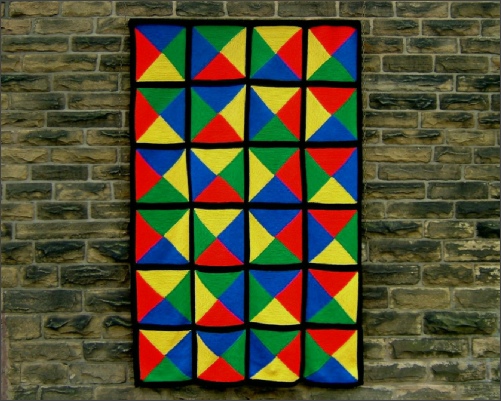




Shortly before Woolly Thoughts was published my mother had suddenly started taking an interest in knitting again, and so had her neighbour, Beryl, who was a keen knitter. They had both produced baby cardigans, then other larger garments, from vague written instructions. They had proved that the methods worked and they could progress to designs of their own, from the ideas in the book. There was a certain attraction to working in small pieces. This type of knitting gave a sense of having achieved something after each piece and the urge to move on to another. Mum was hooked and so was her neighbour. I called on their services for four afghans, and parts of a fifth. I still find it incredible that my mother could maintain interest in knitting long enough to complete something the size of a single bed when she had not been able to finish a cardigan for me when I was a small child.
First Mum knitted twenty-
Mathematically, it solved a problem that occurs frequently, in many different formats, such as ‘How many different ways can four people be seated round a table?’ When given such a problem many pupils approach it in a completely random manner then find it difficult to recognise when duplicates have been included. The design tries to present a logical order for being sure that none have been missed and none used twice. Looking across the rows of squares it can be seen that the only difference between one square and the next is that it has been rotated. There are only six totally different squares. Looking down it can be seen that some colours are consistently in the same positions while others are moved around until all the combinations have been found.
For some pupils a pictorial representation of the problem was a revelation. Being able to turn the people into colours opened a door for some who struggled with such concepts. Were we teaching Maths or Logic? Did it matter? We were encouraging children to think, and clear thinking has to be a good thing for mathematical learning.
The number of combinations for four colours is 4 x 3 x 2 x 1 = 24.
Have It All Ways was the first to be made with the intention of using it for teaching
in school. It was never going to see use as a blanket. It was a wall-
From this time on there was always at least one large item hanging on the wall in
my classroom. I was very fortunate that I had a very large old-
The reaction to Have It All Ways surpassed anything I had expected. We had made it
because it seemed a good idea. There were no big plans about its long time use and
no suggestion of where it might be leading us. It looked good. It was a piece of
textile art and some might never realise it had another purpose. It was so large,
bright and colourful it attracted attention and no class could come into the room
without someone saying ‘What’s that?’. The scale factor was something I hadn’t accounted
for. The children I was teaching often had a poor command of English and this tactile
item did more to encourage them to express themselves than any formal lesson would
ever have done. They could touch and point and show exactly which part they were
referring to. When it was put down on the floor ten or twenty of them could prod
and poke and explain to each other in a mixture of languages. This just isn’t possible
with pictures on a normal-
At various times during the day, heads would appear round the door (which was very rarely closed) and children would creep in to see these things they had heard about. It wasn’t only children. Some members of staff were the same – but more of that later.
